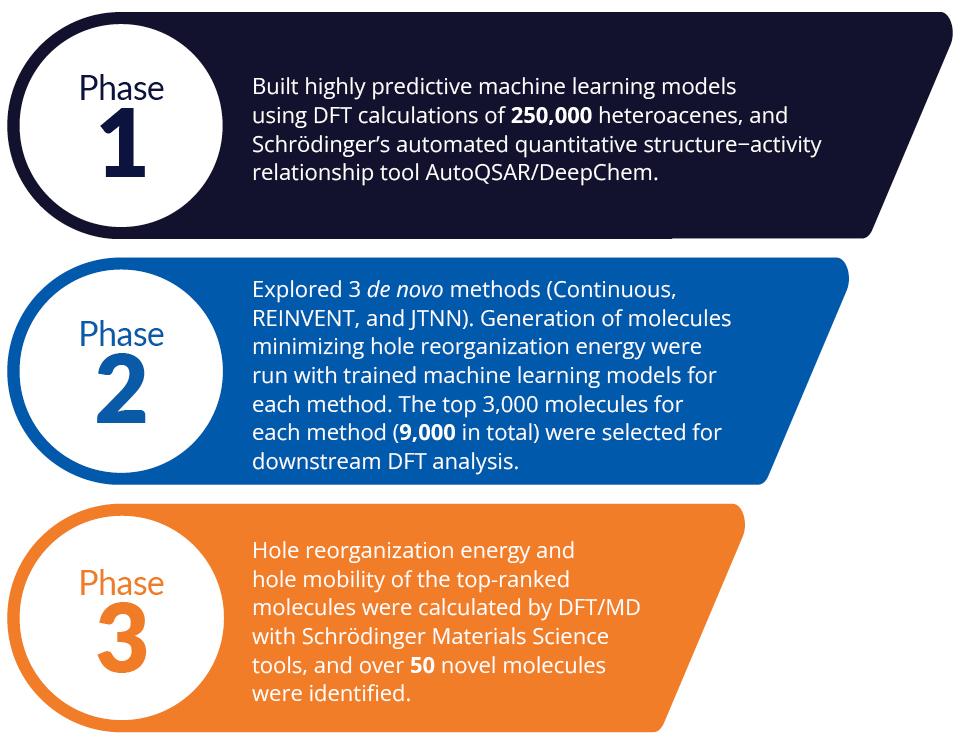De novo design of hole-conducting molecules for organic electronics
Panasonic and Schrödinger scientists designed over 50 novel molecules with improved hole mobility by performing large-scale density functional theory (DFT) calculations and machine learning inverse design.

Executive Summary
Tremendous Time Saved and Cost Reduced
- 3 de novo design methods developed and assessed
- 14 million molecules enumerated and screened
- 9,000 DFT calculations performed
- Over 50 molecules identified with target performance profile
Performance Improved
Identified molecules with lower hole reorganization energy (up to 22% reduction) than the lowest one in training dataset
Highly Predictive Machine Learning (ML) Models Developed
Leveraged data based on DFT calculations of 250,000 molecules
New Insights Proposed
High quality de novo design complements molecular enumeration and virtual screening
Charge carrier mobility is one of the most important characteristics of semiconductor materials.
Applications in printed electronics demand molecules with high mobility. Despite rapid progress toward discovery of new molecules with improved mobility, challenges persist. For example, the impact of topological shape of the molecules on the magnitude of hole mobility is not well understood for optimized molecular design, and it can be extremely costly and time-consuming to synthesize and assess every candidate molecule. Atomic simulations and machine learning technologies can reveal novel insights which are inaccessible to experimental methods alone.
“With Schrödinger’s advanced simulation tools, we were able to explore millions of molecules and target tens of potential candidates within a short period of time, which is simply unfeasible with traditional approaches. This level of computational power changes the way we innovate. Both the scientific expertise and the excellence of technology Schrödinger brings to the table give us confidence in future collaborations.”
Approach
Scientists at Panasonic are challenged to develop novel organic semiconductor materials with higher efficiency. In order to drive innovation, Panasonic teamed up with Schrödinger for de novo design of new molecules leveraging the computational power and expertise of Schrödinger of high-throughput DFT calculations, machine learning/deep learning model building, and chemical enumeration.
Results
Scientists from Panasonic and Schrödinger performed a thorough benchmark study of three de novo methods and identified molecular structures in the heteroacene family, which may show improved carrier transport properties. 1 Schrödinger demonstrated strong large-scale computing capabilities and in-house expertise in machine learning to develop de novo methods based on knowledge and literature reports, building bayesian optimizers and reward engineering.
Conclusion
Scientists from Panasonic and Schrödinger have applied three major classes of de novo molecular design (inverse design) methods to the challenging problem of improving charge carrier mobility in materials science. They evaluated the performance of these methods via large-scale DFT calculation of hole reorganization energy. These methods present an attractive complement to molecular enumeration and virtual screening, and recent advances in deep learning for de novo design have yielded promising results for the design of novel materials.
- Over 50 molecules were identified to have lower hole reorganization energy than lowest data in the training set (up to 22% reduction). We expect significant enhancement in hole mobility by the reduction of the reorganization energy in the newlydesigned molecules.
- The best scoring compound was found by the JTNN method, followed by REINVENT. However, on the whole, the REINVENT method generated the best top 1,000 molecules.
- Based on the findings, the scientists propose that high-quality de novo methods should optimize for compounds that “fill holes” in the space of the enumeration, generating highly targeted molecules.
References
-
De Novo Design of Molecules with Low Hole Reorganization Energy Based on a Quarter-Million Molecule DFT Screen
Gabriel Marques*, Karl Leswing, Tim Robertson, David Giesen, Mathew D. Halls, Alexander Goldberg, Kyle Marshall, Joshua Staker, Tsuguo Morisato, Hiroyuki Maeshima, Hideyuki Arai, Masaru Sasago, Eiji Fujii, and Nobuyuki N. Matsuzawa* J. Phys. Chem. A 2021, 125, 33, 7331–7343.
Software and services to meet your organizational needs
Industry-Leading Software Platform
Deploy digital drug discovery workflows using a comprehensive and user-friendly platform for molecular modeling, design, and collaboration.
Research Enablement Services
Leverage Schrödinger’s team of expert computational scientists to advance your projects through key stages in the drug discovery process.
Scientific and Technical Support
Access expert support, educational materials, and training resources designed for both novice and experienced users.
